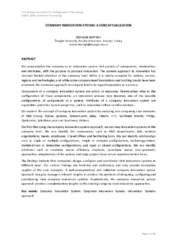Company innovation system: a conceptualization
| dc.contributor.author | den Hartigh, Erik | |
| dc.contributor.editor | Nunes, B. | |
| dc.contributor.editor | Emrouznejad, A. | |
| dc.contributor.editor | Bennett, D. | |
| dc.contributor.editor | Pretorius, L. | |
| dc.date.accessioned | 2020-05-04T21:47:24Z | |
| dc.date.available | 2020-05-04T21:47:24Z | |
| dc.date.issued | 2018-04-25 | |
| dc.identifier.isbn | 978 1 85449 453 5 | |
| dc.identifier.uri | http://hdl.handle.net/10679/6551 | |
| dc.identifier.uri | https://www2.aston.ac.uk/migrated-assets/applicationpdf/aston-business-school/368435-IAMOT2018_paper_169.pdf | |
| dc.description.abstract | We conceptualize the company as an innovation system that consists of components, relationships and attributes, with the purpose to produce innovation. The systems approach to innovation has received limited attention at the company level. While it is widely accepted for nations, sectors, regions and technologies, and while some company-level foundations and building blocks have been proposed, the dominant approach at company level is to regard innovation as a process. Components of a company innovation system are actors or resources. Relationships refer to the configuration of these components: an innovation process now becomes one of the possible configurations of components in a system. Attributes of a company innovation system are capabilities and other system properties, such as innovative culture or infrastructure. We explore the concept of company innovation system by analyzing and comparing case examples of ABB Group, Adobe Systems, Amazon.com, eBay, Hitachi, HTC, Lockheed Martin, Philips, Qualcomm, Salesforce.com and Southwest Airlines. We find that using the company innovation system approach, we can map innovation systems at the company level. We can identify the components, such as R&D departments, labs, venture organizations, teams, employees, C-level offices and facilitating tools. We can identify relationships such as single or multiple configurations, simple or complex configurations, technology-driven, market-driven or interactive configurations, and open or closed configurations. We can identify attributes such as creativity versus efficiency emphasis, systematic versus non-systematic approaches, adaptiveness of the system, and large project-focus versus experimentation focus. The findings indicate that companies design, configure and coordinate their innovation systems in different ways. Our current findings are tentative and preliminary and only provide descriptive insights of the case examples. A well-conceptualized and validated company innovation system approach may give managers relevant insights to address the problems of designing, configuring and coordinating their company innovation systems. Academically, the company innovation system approach provides complementary insights to the existing company-level innovation approaches. | en_US |
| dc.language.iso | eng | en_US |
| dc.publisher | Operations and Information Management Group, Aston Business School, Aston University | en_US |
| dc.relation.ispartof | Towards Sustainable Technologies and Innovation - Proceedings of the 27th Annual Conference of the International Association for Management of Technology | |
| dc.rights | openAccess | |
| dc.title | Company innovation system: a conceptualization | en_US |
| dc.type | Conference paper | en_US |
| dc.publicationstatus | Published | en_US |
| dc.contributor.department | Özyeğin University | |
| dc.contributor.authorID | (ORCID 0000-0003-0526-3646 & YÖK ID 141728) Hartigh, Erik den | |
| dc.contributor.ozuauthor | den Hartigh, Erik | |
| dc.subject.keywords | Company innovation system | en_US |
| dc.subject.keywords | Corporate innovation system | en_US |
| dc.subject.keywords | Innovation | en_US |
| dc.subject.keywords | Systems approach | en_US |
| dc.identifier.scopus | SCOPUS:2-s2.0-85080940909 | |
| dc.relation.publicationcategory | Conference Paper - International - Institutional Academic Staff |
Files in this item
This item appears in the following Collection(s)
Share this page



